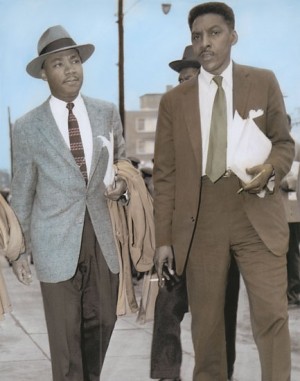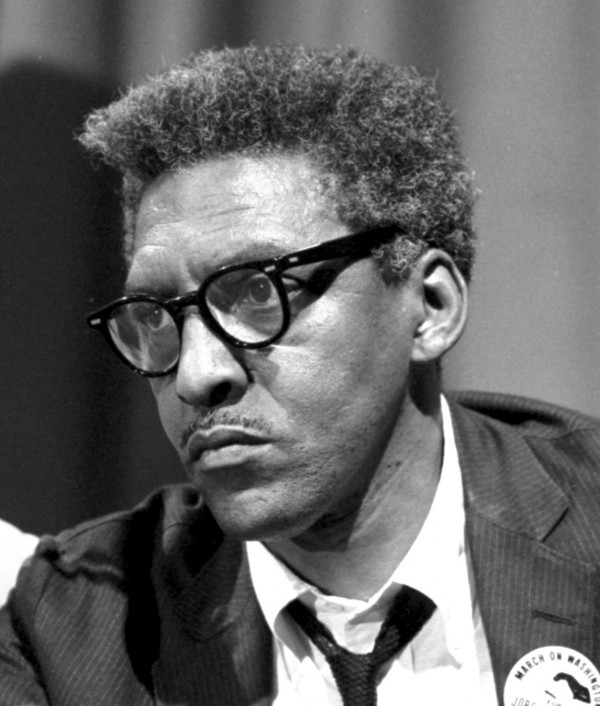WIKIPEDIA: Bayard Rustin (March 17, 1912 – August 24, 1987) was an American leader in social movements for civil rights, socialism, pacifism and non-violence, and gay rights. Rustin was born in West Chester, Pennsylvania. He was a leading activist of the early 1947–1955 civil-rights movement, helping to initiate a 1947 Freedom Ride to challenge with civil disobedience racial segregation on interstate busing. He recognized Martin Luther King, Jr.‘s leadership, and helped to organize the Southern Christian Leadership Conference to strengthen King’s leadership; Rustin promoted the philosophy of nonviolence and the practices of nonviolent resistance, which he had observed while working with Gandhi’s movement in India. In 1948, Rustin traveled to India to learn techniques of nonviolent civil resistance directly from the leaders of the Gandhian movement.
In 1953, Rustin was arrested in Pasadena, California for homosexual activity. Originally charged with vagrancy and lewd conduct, he pleaded guilty to a single, lesser charge of “sex perversion” (as consensual sodomy was officially referred to in California then) and served 60 days in jail. This was the first time that his homosexuality had come to public attention. He had been and remained candid about his sexuality, although homosexuality was still criminalized throughout the United States.
Rustin served as an unidentified member of the American Friends Service Committee‘s task force to write “Speak Truth to Power: A Quaker Search for an Alternative to Violence,”[11] published in 1955. This was one of the most influential and widely commented upon pacifist essays in the United States. Rustin  had wanted to keep his participation quiet, as he believed that his known sexual orientation would be used by critics as an excuse to compromise the 71-page pamphlet when it was published. It analyzed the Cold War and the American response to it and recommended non-violent solutions.
had wanted to keep his participation quiet, as he believed that his known sexual orientation would be used by critics as an excuse to compromise the 71-page pamphlet when it was published. It analyzed the Cold War and the American response to it and recommended non-violent solutions.
Rustin took leave from the War Resisters League in 1956 to advise Martin Luther King Jr. on Gandhian tactics. King was organizing the public transportation boycott in Montgomery, Alabama known as the Montgomery Bus Boycott. According to Rustin, “I think it’s fair to say that Dr. King’s view of non-violent tactics was almost non-existent when the boycott began. In other words, Dr. King was permitting himself and his children and his home to be protected by guns.” Rustin convinced King to abandon the armed protection.[12]
The following year, Rustin and King began organizing the Southern Christian Leadership Conference (SCLC). Many African-American leaders were concerned that Rustin’s sexual orientation and past Communist membership would undermine support for the civil rights movement. U.S. Representative Adam Clayton Powell, Jr., who was a member of the SCLC’s board, forced Rustin’s resignation from the SCLC in 1960 by threatening to discuss Rustin’s morals charge in Congress.[13] Although Rustin was open about his sexual orientation and his conviction was a matter of public record, the events had not been discussed widely outside the civil rights leadership.
Despite shunning from some civil rights leaders, “[w]hen the moment came for an unprecedented mass gathering in Washington, Randolph pushed Rustin forward as the logical choice to organize it.”[14] A few weeks before the March on Washington for Jobs and Freedom in August, 1963, Senator Strom Thurmond railed against Rustin as a “Communist, draft-dodger, and homosexual,” and had the entire Pasadena arrest file entered in the record.[14] Thurmond also produced an FBI photograph of Rustin talking to King while King was bathing, to imply that there was a same-sex relationship between the two. Both men denied the allegation of an affair. Despite King’s support, NAACP chairman Roy Wilkins did not want Rustin to receive any public credit for his role in planning the march. Nevertheless, he did become well known. On September 6, 1963 Rustin and Randolph appeared on the cover of Life magazine as “the leaders” of the March. MORE

